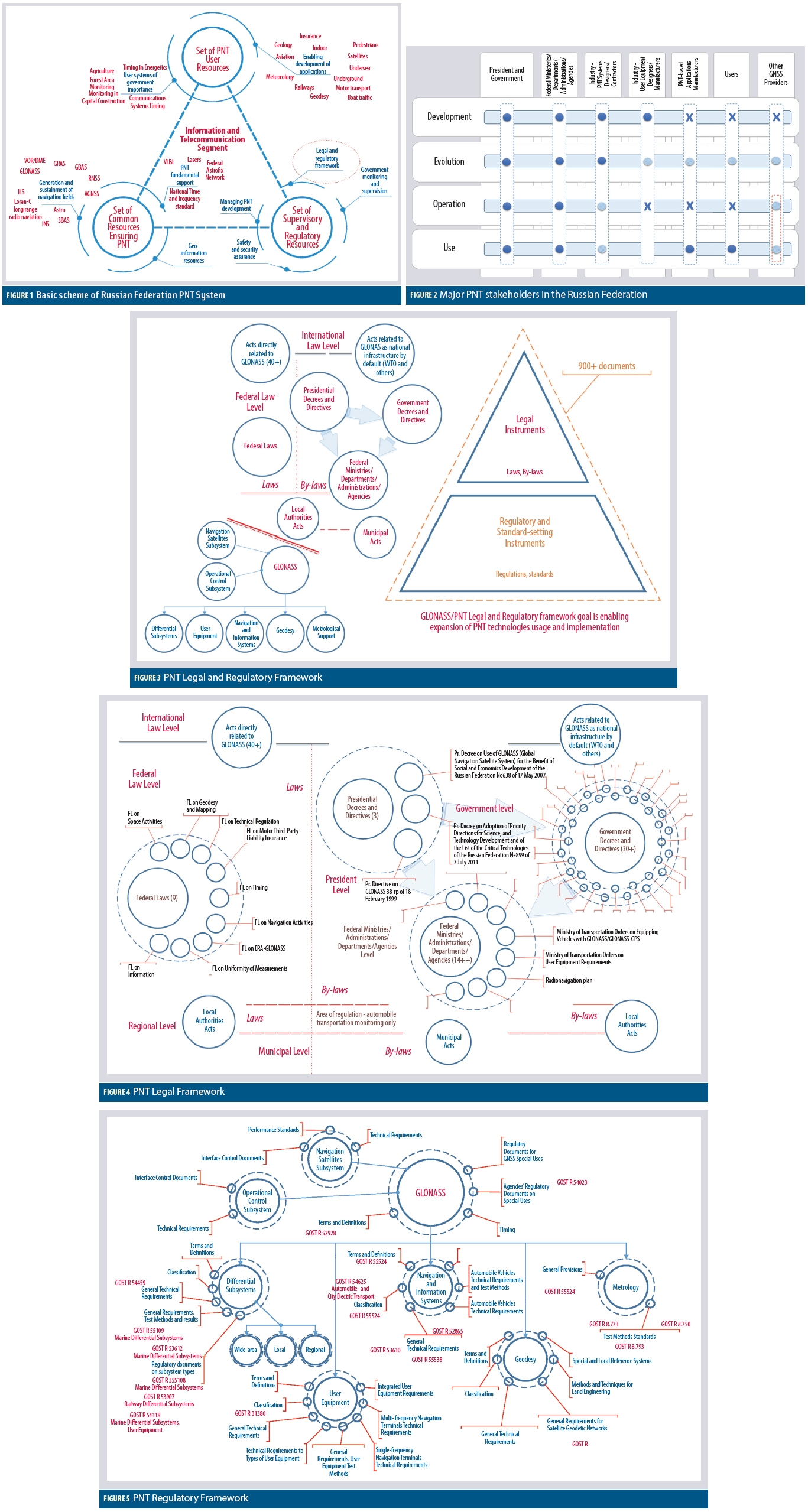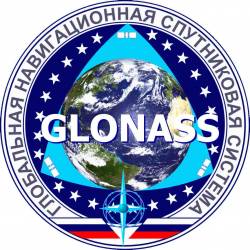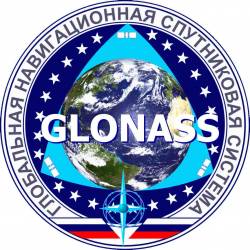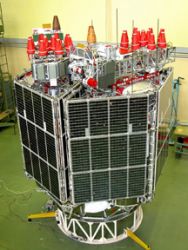The legal and regulatory framework of the Russian Federation covers not only the GLONASS system, but the country’s overall positioning, navigation and timing (PNT) system as well.
The term PNT is a synonym for navigation activities as defined in the Federal Law on Navigation Activities. The PNT system in the Russian Federation is defined as the combination of administrative and technical means that provide spatial and time data to all user groups, with GLONASS as a key element.

Figure 1 (see inset photo, above right, for all figures) shows a basic scheme of the Russian PNT system. It consists of four main elements:
- a set of common resources ensuring PNT (deployment and maintenance of navigation system and services, including GLONASS, PNT fundamental support, as well as relevant geo-information resources)
- a set of PNT user resources (consisting of user systems of public importance, including timing in energy or communications networks as well as systems used for aviation, meteorology, or geodesy)
- an information and telecommunications segment providing all necessary data links, including relevant exchange and transmission procedures
- a set of supervisory and regulatory resources, including safety and security assurance, public PNT management, monitoring and supervision, as well as the applicable legal and regulatory framework.
Major PNT Stakeholders in the Russian Federation
Figure 2 shows the major stakeholders involved in the Russian PNT system and their relationship over the PNT lifecycle: development, operations, usage, and evolution.
The stakeholders include the president, the government, several federal executive authorities (FEAs), PNT system designer and user equipment manufacturers, PNT-based applications and service providers, and the users.
The figure provides only a general overview of the governance structures. Full involvement of a certain stakeholder in a certain lifecycle aspect is shown by blue circles, light blue is used where the involvement is partial, and a cross is used in case of no involvement.
Legal and Regulatory Framework
The Russian PNT system is subject to a highly complex legal and regulatory framework consisting of more than 900 applicable documents on various levels. The overall framework can be divided into legal and regulatory elements.
The legal framework in Russia deals with subject-to-subject relationships and the regulatory framework, subject-to-object relationships. In simplified terms, “subject” means individuals or communities of any kind, and “object” means physical things such as technical equipment and systems. However, titles of laws or regulations do not always properly reflect this; so, there are legal acts with substantial regulatory (technical) elements, and vice versa.
Figure 3 provides a general overview on the legal (upper left) and regulatory (lower) framework.
The legal framework includes relevant international law, all levels of federal law (including residential and governmental decrees and directives, as well as FEA bylaws and acts of regional authorities, down to municipal ordinances.
The regulatory framework mainly deals with the GLONASS system and its functional parts. Various sets of acts define navigation satellites’ subsystems, operational control subsystems, differential subsystems, user equipment, navigation and information systems, geodetic and metrological support, and data provision.
Legal Framework
Figure 4 provides a more detailed scheme of the legal framework in the Russian Federation.
International legal instruments to which Russia is party are at the highest level. These can be divided into the more than 40 instruments that involve GLONASS directly and those involving it indirectly, such as World Trade Organization (WTO) agreements. The second is the federal level and includes laws and bylaws. Presidential and governmental decrees and directives, as well as FEA acts, belong to this category.
The third level encompasses acts on regional level, again including laws and bylaws. This level is mainly focused on road transport monitoring and infrastructure, especially for governmental users. Finally, there is the level of municipal bylaws.
Of course, a broad range of strategic or programmatic documents also exist, such as development programs, strategies, or concepts issued by various executive authorities. These do not form part of the legal and regulatory framework although they may strongly determine its further development. Frequently, they also contain so-called “rules and principles” of a regulatory nature. Around 80 such relevant strategic or planning documents deal with PNT. PNT-related legal and regulatory instruments exist on all of the previously described levels and include instruments of all types. In most cases — about 60 percent — these cover PNT along with other issues.
Those fully devoted to PNT exist mainly on the regional or municipal levels; less than 20 percent are found on the federal level. As GLONASS and other PNT systems and services are mainly used in the transport sector, the most active stakeholder is the Ministry of Transport, which has responsibility for around 9 percent of all relevant instruments.
The most important legal instruments affecting the use and operation of GLONASS or PNT in general include the following:
- Federal laws — Federal Law no. 5663-1 on Space Activities issued 13.07.2015, Federal Law no. 431 on geodesy and mapping issued 30.12.2015, Federal Law no. 22 on navigation activities issued 13.07.2015, Federal Law no. 395 on ERA-GLONASS system issued 13.07.2015, and Federal Law no. 102 on uniformity of measurements issued 13.07.2015.
- Presidential decrees and directives: President’s Decree no. 638 on Use of GLONASS for the Benefit of Social and Economic Development of the Russian Federation, issued 17.05.2007.
- Governmental decrees and Directives — Decree on GNSS usage in Transportation and Geodesy; FEA powers in GLONASS sustainment, development and usage; some aspects of ERA-GLONASS development and usage.
- FEA bylaws: Federal Radionavigation Plan; Ministry of Transportation Orders on Equipping Vehicles with GLONASS/GLONASS-GPS; Ministry of Transportation Orders on User Equipment Requirements (Ministry of transportation Orders no. 20, 23, 35, 195, 311, 319, 348, etc.).
Regulatory Framework
Figure 5 shows a more detailed scheme of the regulatory framework, which, as mentioned earlier, mainly deals with the GLONASS system.
A number of sets of acts define the GLONASS system, including terms and definitions; regulatory documents for GNSS special uses; agencies’ regulatory documents on special uses, and documents defining timing.
In addition, acts define the two main components of GLONASS: the Operational Control Subsystem (interface control documents or ICDs and technical requirements) and the Navigation Satellites Subsystem (ICD, performance standards and technical requirements).
Other elements of the Russian PNT system are also defined by sets of regulatory acts.
The first part concerns sets of acts generally relating to differential GLONASS subsystems. The five sets include terms and definitions, classification, general technical requirements, test methods and results, and regulatory documents on subsystem types. Further set of acts address the various types of differential subsystems: wide area, local, and regional.
The second part defines the user equipment and includes eight sets of acts. The third part has six sets on navigation and information system and the fourth part has six sets on geodesy. The fifth and last part concerns metrology with two sets of acts.
Generally, all the aforementioned sets of acts fully cover all needs of the various PNT users. However, two groups of problems have been identified in the legal and regulatory framework and are now being addressed by relevant stakeholders.
Collisions in the Legal and Regulatory Framework
Of these groups of problematic areas, one group exists on the national and the other on the international level.
National level issues include the following:
- Insufficient coordination within the legal and regulatory framework has resulted in some cases in collision or gaps. The larger number of instruments are bylaws, not federal laws. Sometimes, these have been adopted with insufficient recognition of the federal law, potentially leading to contradiction or uncertainties. As an example, some bylaws of the Ministry of Transportation (Ministry of Transportation Orders on User Equipment Requirements, and so on) conflict with the federal law “On technical regulation.”
- Because technical guidelines, which are most relevant to users and service providers, are based on bylaws, the aforementioned contradictions or uncertainties may flow down to the technical level.
- Insufficient links exist between the legal and regulatory acts concerning GLONASS and those concerning other aspects of the PNT system, such as geodesy, cartography and timing
- Lack of coordination in PNT legal and regulatory activities has arisen between the various levels of government, especially on the FEA level.
- FEA acts may not meet certain requirements of the federal law “On technical regulation.”
On the international level, the Russian Federation remains committed to provide for all international users free and non-discriminatory access to the GLONASS open signals, without intentional system degradation. The Russian Federal Space Agency acts as coordinator at this level and promotes international cooperation.
In order to support GLONASS use, federal authorities and organizations within their jurisdiction are mandated to use GLONASS- and GLONASS/GPS-based user equipment. For regional and local authorities, use of GLONASS- and GLONASS/GPS-based user equipment is recommended but not mandatory. Such measures promoting the use of the specified GNSS systems are not without criticism, especially with regard to market- access rules under the WTO agreements. The matter of market access is subject to exchanges within the International Committee on GNSS (ICG) Providers Forum.
Way Forward
These problematic issues on the national level can be addressed by a systematization and harmonization of existing acts, namely by overarching acts called “codes” in Russian legal practice.
One key element could be a future federal law currently entitled the “Navigation Code.” Such a code would cover all different PNT elements and activities.
Under the Russian legal system, a code is part of federal law. However, compared to other federal laws, a code is designed to have a long continuity, consolidated nature, considerable volume, and complicated structure Currently, the navigation code is widely discussed within the legal, administrative and scientific communities in the Russian Federation. If adopted, it would become the basis for a more harmonized legal and regulatory framework in the Russian Federation.
In addition, a roadmap for the further development of the PNT legal and regulatory framework is currently under preparation. It will include three main documents:
- PNT development strategy
- Legal and regulatory framework development strategy
- National and international regulations and standards development strategy.
These documents are mainly aiming to support the development and adoption procedures for the Navigation Code.
Conclusion
This article provides only a brief overview of legal and regulatory framework for PNT in the Russian Federation. The framework is highly complex. However, despite some problematic areas, it is sufficiently elaborated to allow PNT user groups to function efficiently. The framework is now developing quickly and we can expect that the problems we have discussed will be solved in the near future. A key element in this respect will be the (“potential” or “future”) navigation code currently under discussion.
Additional Resources
Bolkunov, A., “GLONASS and GNSS Performance Standards: Status and Plans,” Tenth Meeting of the International Committee on Global Navigation Satellite Systems. Working Group A: Systems, Signals and Services. Boulder, Colorado, United States, November 3–5, 2015, pp. 1-11
Bolkunov, A., “GLONASS/PNT Sustainment and Development Legal and Regulatory Framework: Status and Plans,” Munich Satellite Navigation Summit 2015: Session 5. Legal Issues of GNSS Market Development. Munich, Germany, March 24–26, 2015, pp. 1–9
International Committee on Global Navigation Satellite Systems: The Way Forward. United Nations, Office for Outer Space Affairs, 2016






